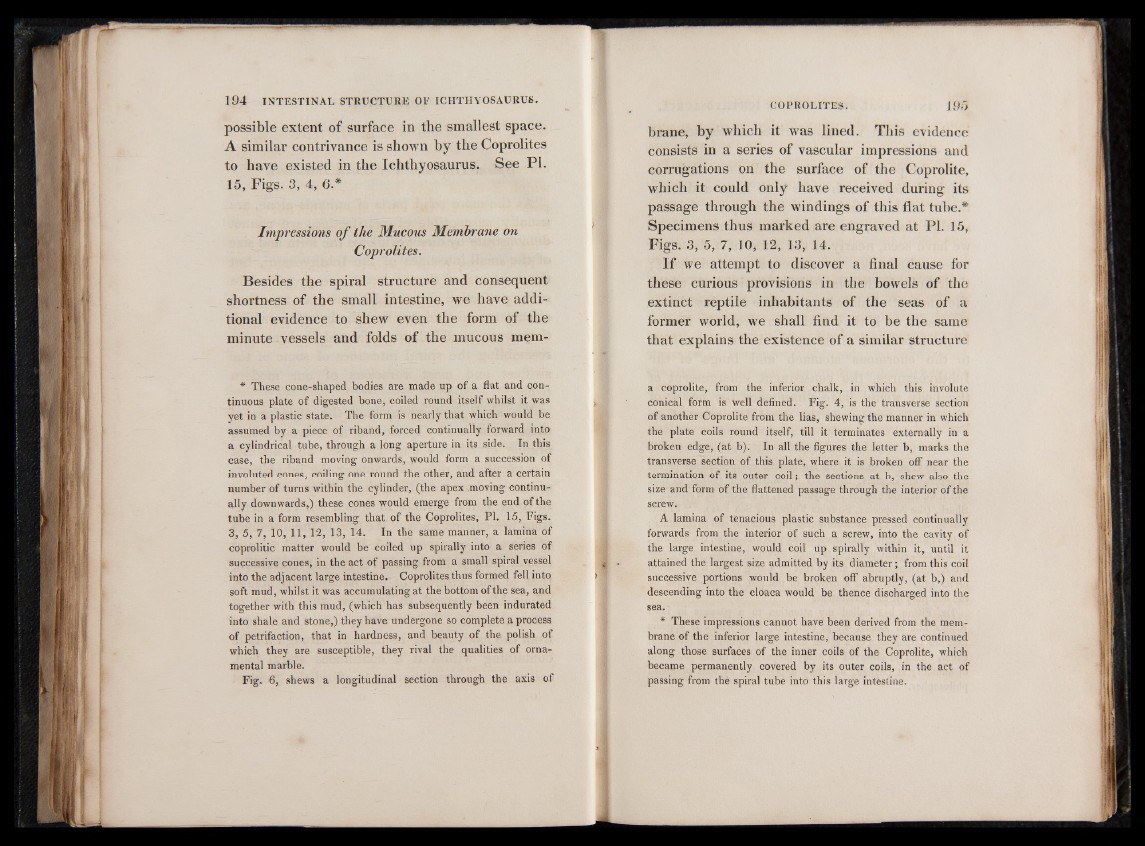
possible extent of surface in the smallest space.
A similar contrivance is shown by the Coprolites
to have existed in the Ichthyosaurus. See PI.
15, Figs. 3, 4, 6.*
Impressions o f the Mucous Membrane on
Coprolites.
Besides the spiral structure and consequent
shortness of the small intestine, we have additional
evidence to shew even the form of the
minute vessels and folds of the mucous mem*
These cone-shaped bodies are made up of a flat and continuous
plate of digested bone, coiled round itself whilst it was
yet in a plastic state. The form is nearly that which would be
assumed by a piece of riband, forced continually forward into
a cylindrical tube, through a long aperture in its side. In this
case, the riband moving onwards, would form a succession of
involuted cones, coiling one round the other, and after a certain
number of turns within the cylinder, (the apex moving continually
downwards,) these cones would emerge from the end of the
tube in a form resembling that of the Coprolites, PI. 15, Figs.
3, 5, 7, 10, 11, 12, 13, 14. In the same manner, a lamina of
coprolitic matter would be coiled up spirally into a series of
successive cones, in the act of passing from a small spiral vessel
into the adjacent large intestine. Coprolites thus formed fell into
soft mud, whilst it was accumulating at the bottom of the sea, and
together with this mud, (which has subsequently been indurated
into shale and stone,) they have undergone so complete a process
of petrifaction, that in hardness, and beauty of the polish of
which they are susceptible, they rival the qualities of ornamental
marble.
Fig. 6, shews a longitudinal section through the axis of
brane, by which it was lined. This evidence
consists in a series of vascular impressions and
corrugations on the surface of the Coprolite,
which it could only have received during its
passage through the windings of this flat tube.*
Specimens thus marked are engraved at PI. 15,
Figs. 3, 5, 7, 10, 12, 13, 14.
I f we attempt to discover a final cause for
these curious provisions in the bowels of the
extinct reptile inhabitants of the seas of a
former world, we shall find it to be the same
that explains the existence of a similar structure
a coprolite, from the inferior chalk, in which this involute
conical form is well defined. Fig. 4, is the transverse section
of another Coprolite from the lias, shewing the manner in which
the plate coils round itself, till it terminates externally in a
broken edge, (at b). In all the figures the letter b, marks the
transverse section of this plate, where it is broken off near the
termination of its outer coil; the sections at b, shew also the
size and form of the flattened passage through the interior of the
screw.
A lamina of tenacious plastic substance pressed continually
forwards from the interior of such a screw, into the cavity of
the large intestine, would coil up spirally within it, until it
attained the largest size admitted by its diameter; from this coil
successive portions would be broken off abruptly, (at b,) and
descending into the cloaca would be thence discharged into the
sea.
* These impressions cannot have been derived from the membrane
of the inferior large intestine, because they are continued
along those surfaces of the inner coils of the Coprolite, which
became permanently covered by its outer coils, in the act of
passing from the spiral tube into this large intestine.